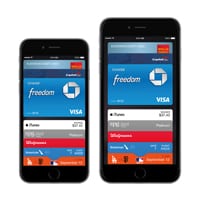 Apple today announced Apple Pay, a new category of service that will transform mobile payments with an easy, secure and private way to pay.
Apple today announced Apple Pay, a new category of service that will transform mobile payments with an easy, secure and private way to pay.
Starting in October, with iPhone 6 and iPhone 6 Plus, Apple Pay will be available in the US as a free update to iOS 8. Apple Pay will work in stores with iPhone 6, iPhone 6 Plus and Apple Watch. Apple Pay APIs will be available to developers in iOS 8 so they can enable purchasing physical goods within their apps on iPhone 6 and iPhone 6 Plus.
Apple Pay works with iPhone 6 and iPhone 6 Plus through a groundbreaking NFC antenna design, a dedicated chip called the Secure Element, and the security and convenience of Touch ID.
[RELATED: Industry Experts Abuzz Over Apple Pay]
Apple Pay will also work with the newly announced Apple Watch, extending Apple Pay to over 200 million owners of iPhone 5, iPhone 5c and iPhone 5s worldwide.
According to Apple, hundreds of millions of iPhone users can simply add their credit or debit card on file from their iTunes Store account.
[RELATED: Staples, Whole Foods to Accept Apple Pay]
Apple Pay supports credit and debit cards from the three major payment networks, American Express, MasterCard and Visa, issued by the most popular banks including Bank of America, Capital One Bank, Chase, Citi and Wells Fargo, representing an estimated 83% of credit card purchase volume in the U.S.
In addition to the 258 Apple retail stores in the US, some of the nation’s leading retailers that will support Apple Pay include Bloomingdale’s, Disney Store and Walt Disney World Resort, Duane Reade, Macy’s, McDonald’s, Sephora, Staples, Subway, Walgreens and Whole Foods Market. Apple Watch will also work at the over 220,000 merchant locations across the US that have contactless payment enabled. Apple Pay is also able to make purchases through apps in the App Store.
“Security and privacy is at the core of Apple Pay,” said Eddy Cue, Apple’s senior vice president of Internet Software and Services. “When you’re using Apple Pay in a store, restaurant or other merchant, cashiers will no longer see your name, credit card number or security code, helping to reduce the potential for fraud.”
Cue added that Apple doesn’t collect your purchase history, so it doesn’t know what you bought, where you bought it or how much you paid for it. And if a user’s iPhone is lost or stolen, he or she can use Find My iPhone to quickly suspend payments from that device.
